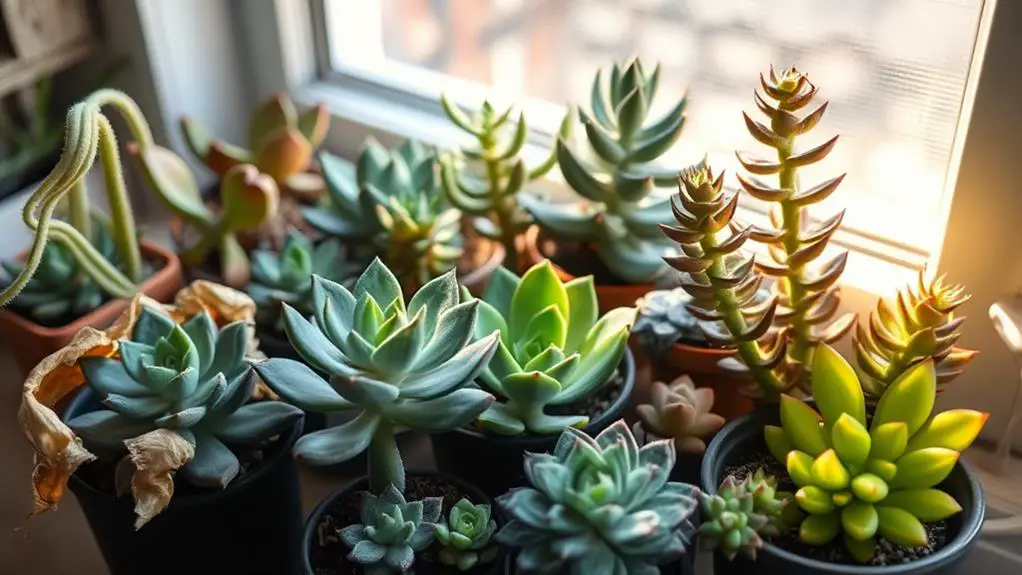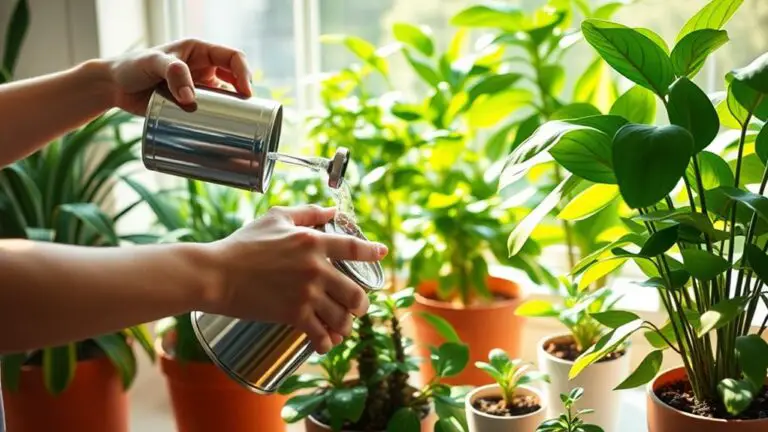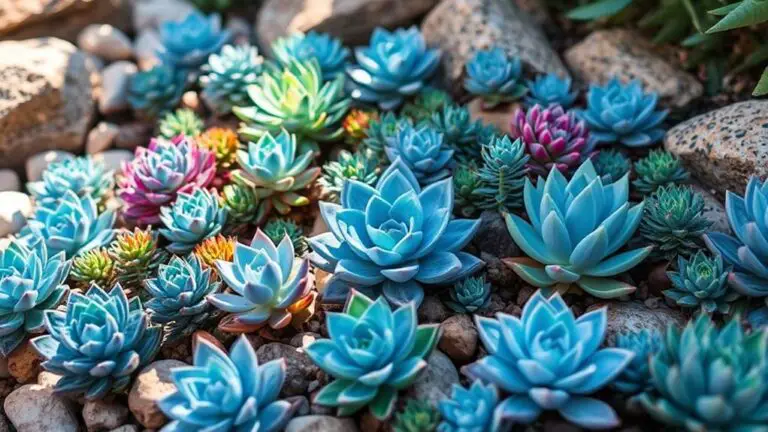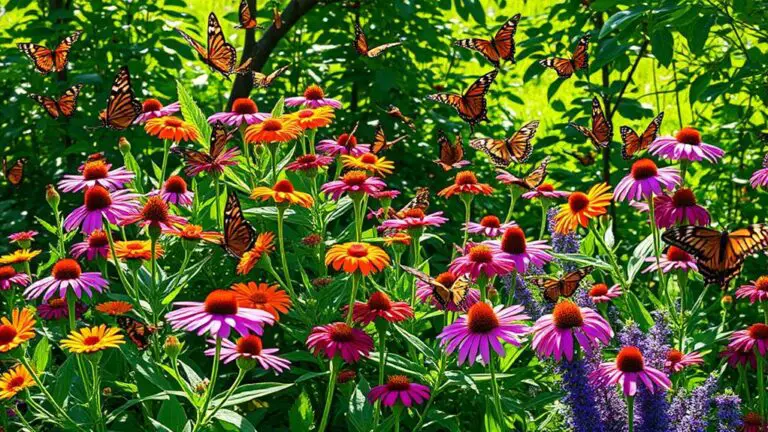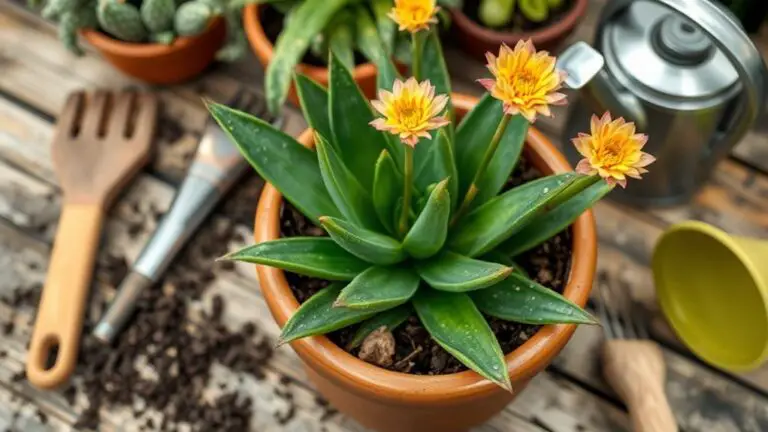What Is Succulent Dormancy and Why Does It Happen?
Have you ever noticed your succulents looking a bit lackluster during certain times of the year? This might be due to succulent dormancy, a phase where these resilient plants slow their growth and metabolic activities to conserve energy. But why do they do this, and how can you identify and manage it? Understanding the causes and recognizing the signs of dormancy are essential for keeping your succulents thriving. Let's explore what triggers this fascinating survival mechanism and how it varies across different species and seasons.
Definition of Succulent Dormancy

Succulent dormancy is a temporary phase where a succulent's growth and metabolic activities slow down markedly, helping the plant conserve energy during tough environmental conditions. When a succulent enters dormancy, it's like the plant is taking a rest.
During this dormancy period, you mightn't see much change on the outside, which can be confusing. You might even think the plant is dead, but it's just in a resting state.
Metabolic activity in succulents decreases considerably during dormancy. This slowdown allows the plant to survive when conditions aren't ideal, like during extreme temperatures or long dry spells.
Succulents are smart this way—they know how to save their energy.
Understanding the dormant period is essential for proper care. For instance, summer growers go dormant in winter, and winter growers go dormant in summer.
During these times, it's important to adjust your watering routine. Too much water can stress the plant or cause it to rot. Instead, water sparingly to mimic the natural dry conditions.
Causes of Dormancy

Understanding why succulents go dormant helps you provide better care during these resting periods. Dormancy in succulents is mainly triggered by extreme environmental conditions. When temperatures soar above 90°F during the day or drop below 60°F at night for extended periods, your succulents will slow down their metabolic activity. This change helps them conserve energy and survive the harsh conditions.
Lack of water and high air dryness also play significant roles in causing dormancy. When water is scarce, succulents reduce their growth to minimize water loss. This is vital for their survival in hot, dry climates.
If you're growing succulents, understanding their dormancy periods can help you adjust your care routine. Each species has a different dormancy pattern. Some succulents go dormant in the winter, while others rest during the summer months.
This survival mechanism allows them to endure unfavorable conditions until the environment improves. By recognizing these patterns, you can guarantee your succulents get the right care when they need it most.
Summer Dormancy
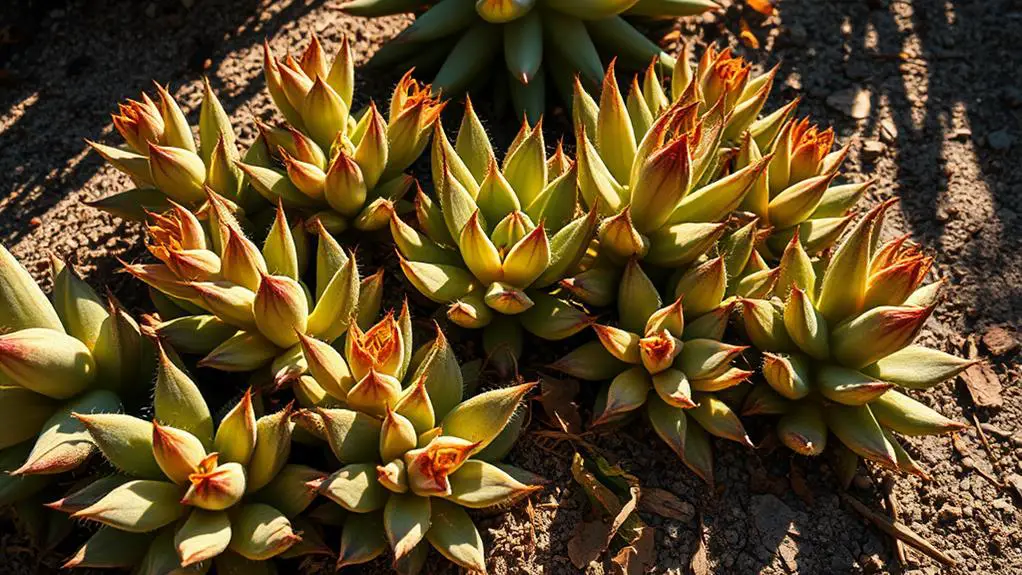
During the intense heat of summer, many winter-growing succulents like Jade plants, Aloe Vera, and Kalanchoe enter a phase of dormancy.
When temperatures rise above 50°F, these plants slow down their growth to conserve energy. This summer dormant phase is a natural adaptation, allowing succulents to survive the hot, dry climates they originate from.
You might notice your succulents shedding leaves or halting new growth during this period. It's their way of conserving resources and ensuring they make it through the extreme heat.
Here's what you should keep in mind:
- Reduce watering frequency: Overwatering can lead to rot and stress.
- Monitor temperatures: Keep your succulents in cooler areas if possible.
- Look for signs of dormancy: Leaf shedding and no new growth are common.
- Be patient: Growth will resume when temperatures drop.
Winter Dormancy
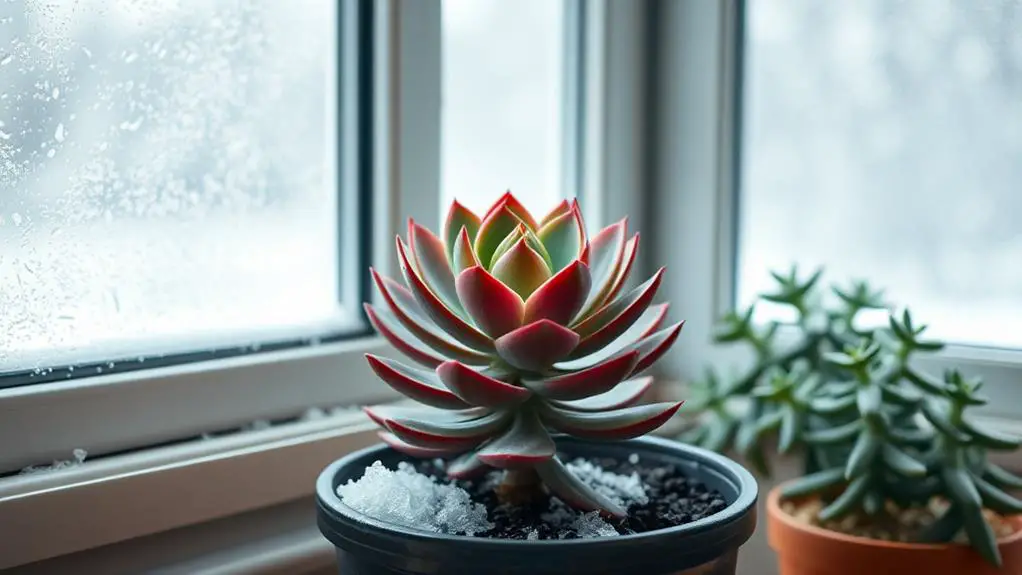
Winter dormancy in succulents like Agave, Euphorbia, and Echeveria means these plants stop growing when temperatures fall below 50°F.
You'll notice signs like leaf shedding, color changes, and no new growth, which indicate they're conserving energy.
To support them, reduce watering and avoid fertilizing until they wake up in spring.
Common Winter Dormant Species
Several succulent species, such as Adenium, Agave, Echeveria, Euphorbia, and Mammillaria, halt their growth during the colder months, entering a state known as winter dormancy.
These common winter dormant species conserve energy by minimizing their metabolic activity and reducing water intake. You might notice signs like leaf shedding or color changes, indicating that your succulent is in its inactive state.
During this period, succulents focus on survival rather than growth. They reduce their metabolic activity to conserve energy, which means they won't need as much water. Overwatering can be a major issue, leading to root rot and other problems. As a result, it's crucial to adjust your watering habits accordingly.
Here are some key points to remember:
- Leaf Shedding: It's normal for succulents to shed leaves during dormancy.
- Color Changes: Some species might change color, signaling their dormancy.
- Reduced Water Needs: Avoid overwatering to prevent root diseases.
- Energy Conservation: Dormant succulents conserve energy by slowing down their metabolism.
Recognizing these signs and adjusting your care routine will help your succulents thrive through the winter months.
You're on the right path to becoming a knowledgeable and confident succulent caretaker!
Seasonal Care Adjustments
Understanding the dormancy cycle of your succulents is just the beginning; now it's time to adapt your care routine to support them through the colder months.
During winter, succulents like Echeveria, Euphorbia, and Agave enter a dormant state, slowing their growth due to cooler temperatures and less light. They need less water during this time, so water them every two weeks or only when the soil is completely dry. This helps prevent root rot and conserves the energy they need.
You don't need to fertilize your succulents during winter dormancy. Since they're not actively growing, they're conserving their energy. Extra nutrients aren't necessary and can even harm them.
If you have succulents indoors, they mightn't show obvious signs of dormancy because of the controlled environment. Keep an eye on them and adjust care if you notice signs of stress.
For outdoor succulents, protect them from extreme cold by using mulch or coverings to insulate them. This keeps them safe during their dormant phase.
Identifying Dormancy Signs
Identifying dormancy signs in your succulents is essential for ensuring proper care during the colder months. During the dormancy period, you'll notice a complete cessation of growth in your plants. This typically happens because of cooler temperatures and less light. Recognizing the signs of winter dormancy is key to maintaining healthy succulents.
Keep an eye out for these common signs:
- Leaf shedding: It's normal for some leaves to drop off.
- Yellowing or browning leaves: This might look alarming, but it's natural.
- Contraction of rosettes: Some varieties pull their leaves in tight.
- Papery covering on leaves: A protective adaptation against harsh conditions.
Healthy succulents will appear static with no new growth, but don't worry. Their roots are alive and ready to grow again once the conditions improve.
Monitoring these signs is vital because it helps you tell the difference between a dormant plant and one that's possibly dead due to rot or other issues.
Indoor Dormancy
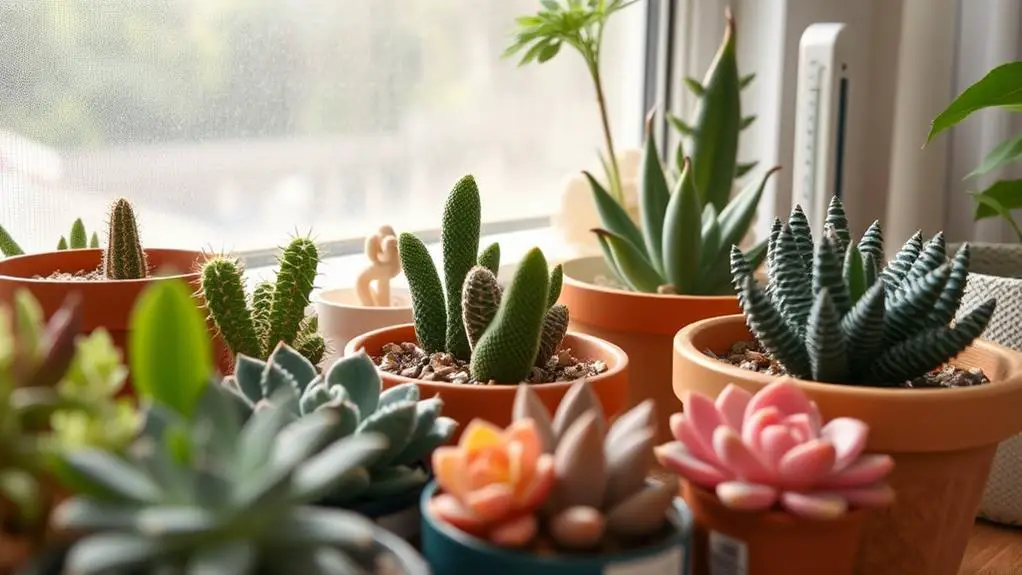
Indoor succulents often experience dormancy periods that can easily go unnoticed due to the stable temperatures and consistent light conditions typically found inside homes.
Indoor succulents like Echeveria, Euphorbia, and Agave usually enter dormancy during the winter months. During this time, you might notice a slowdown in their growth, which is perfectly normal for winter growers. Understanding succulent care during these dormant phases is essential to keeping your plants healthy.
When your indoor succulents are dormant, they require minimal watering. You should water them every two weeks or only when the soil is completely dry to prevent root rot.
Overwatering is a common mistake, so err on the side of caution. Fertilization isn't necessary during dormancy since your succulents are conserving energy and not in active growth.
To help your succulents emerge from dormancy, make certain they receive indirect light. This can encourage new growth when they're ready.
Additionally, once the dormant phase ends, give them a thorough watering to rehydrate the roots. By understanding and adjusting to their dormancy needs, you can confidently support your indoor succulents through their natural cycles.
Outdoor Dormancy
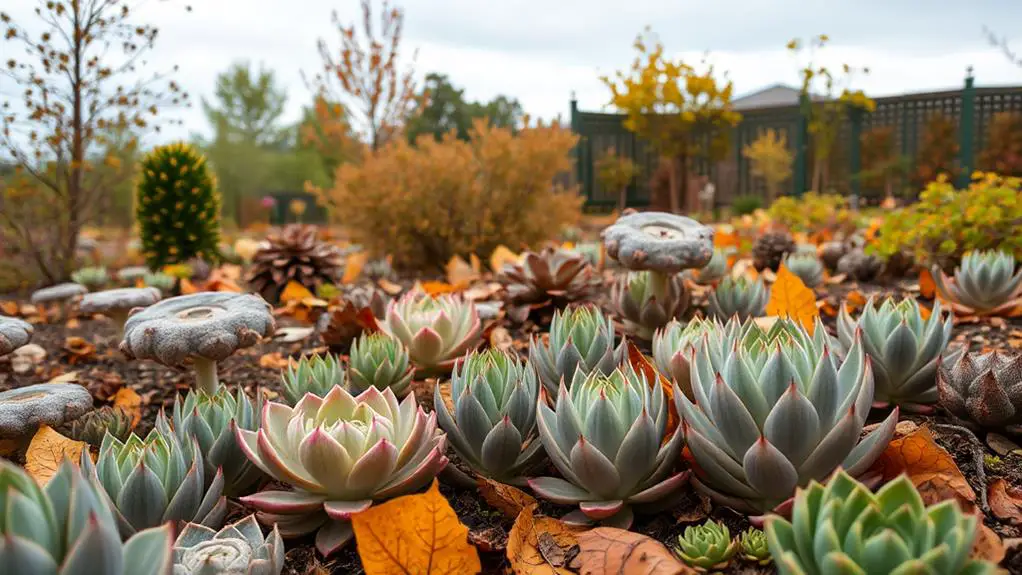
Outdoor succulents, like their indoor counterparts, go through dormancy as an important survival mechanism. This happens in response to fluctuating temperatures and changing environmental conditions. Understanding how outdoor succulents manage dormancy can help you support their health and guarantee they thrive.
When temperatures drop, especially in winter, outdoor succulents like Sempervivum can survive the cold without much care. They reduce their metabolic activity, meaning their growth halts and they need very little water. On the other hand, soft succulents like Echeveria need to be brought indoors to avoid frost damage.
Here's what you need to know about outdoor succulent dormancy:
- Climate Impact: In warmer regions, dormancy is shorter, while colder climates extend this period.
- Water Needs: During dormancy, minimal watering is important, especially for hardy varieties during freezing temperatures.
- Growth Resumption: As spring arrives, outdoor succulents need ample sunlight and careful watering to resume active growth.
- Protection: For soft succulents, indoor shelter during harsh winters is vital to prevent frost damage.
Signs of Dormancy
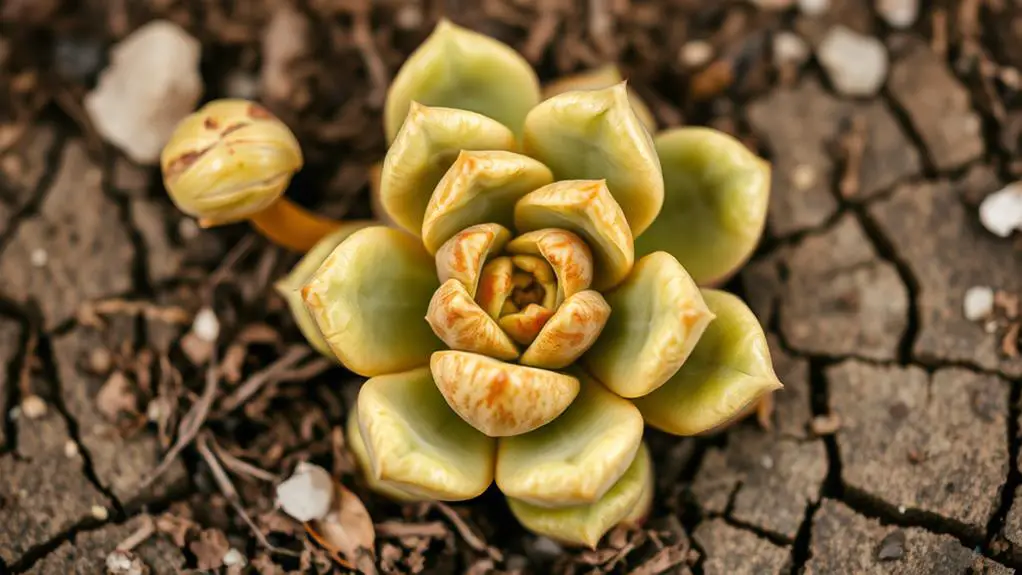
Succulents often signal dormancy through several distinct changes that you can easily observe. First, you'll notice a cessation of growth. During this period, no new leaves or stems will develop. This is a clear sign that your succulent is conserving energy. Additionally, leaf shedding is common. Leaves may turn yellow or brown and drop off as the plant shifts into dormancy.
Another sign to watch for is the contraction of rosettes in rosette-type succulents. The rosettes may appear smaller, indicating reduced physical activity. Sometimes, a papery covering will develop on the leaves, helping to reduce moisture loss. This is another way your succulent conserves energy.
Color changes are also a good indicator. Leaves might turn a deeper green or their color may dull. These changes signal that your succulent is entering a less active phase.
Here's a handy table to summarize these signs:
| Sign | Description | Purpose |
|---|---|---|
| Cessation of Growth | No new leaves or stems | Energy Conservation |
| Leaf Shedding | Leaves turn yellow/brown and fall off | Energy Conservation |
| Rosette Contraction | Rosettes appear smaller | Reduced Physical Activity |
| Papery Covering | Leaves develop a papery layer | Moisture Reduction |
| Color Changes | Leaves turn deeper green or lose color | Indicator of Dormancy |
Reviving Dormant Succulents
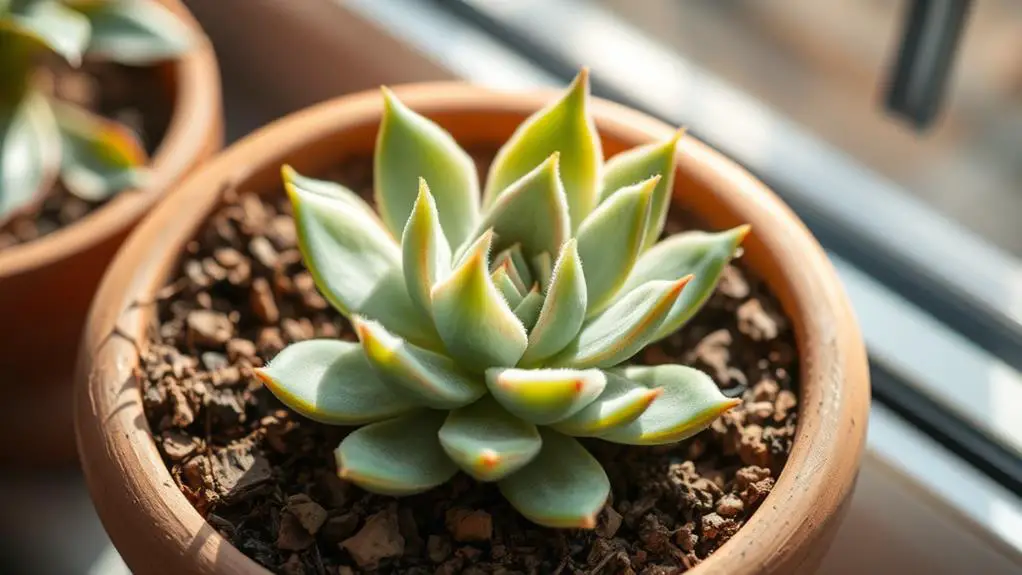
Recognizing the signs of dormancy in your succulents is just the first step. Reviving dormant succulents involves a few vital actions to stimulate growth and guarantee they get the nutrients they need.
Start by providing plenty of indirect light. Succulents often slow down in unfavorable conditions, so indirect light helps wake them up.
Next, thoroughly water your plant. If the soil is dry and the leaves look wrinkled, it's time to rehydrate. Watering is essential for revival.
After that, give your succulent a boost with some fertilizer. Dormant plants benefit from nutrients, and a little fertilizer can encourage new growth.
Here are the key steps to reviving your dormant succulents:
- Provide indirect light to stimulate growth.
- Thoroughly water the plant to rehydrate it.
- Use fertilizer to supply essential nutrients.
- Monitor for signs of recovery, like new leaves or firmer foliage.
Indoor conditions are ideal for this process since you can control the environment better, reducing the risk of temperature fluctuations.
Keep an eye on your succulent for signs of recovery. New leaf growth or firmness returning to the leaves indicates your plant is on the mend.
Be patient and consistent, and your succulent will thrive again.
Caring for Dormant Succulents

Caring for dormant succulents requires a delicate balance to guarantee their health during this resting phase. During dormancy, succulents need minimal watering—usually every two weeks or only when the soil is completely dry. This helps prevent overwatering and root rot, which can be fatal.
Also, avoid fertilizing your dormant succulents. Their metabolic activity slows down considerably, so they don't need extra nutrients.
Re-potting should be postponed until after dormancy. Disrupting the roots during this period can hinder their recovery and growth when they wake up.
It's also essential to protect your succulents from extreme temperature fluctuations and drafts. Maintaining a stable environment helps keep them healthy and stable.
Keep an eye on environmental conditions such as light and humidity. Succulents still need light, but they can tolerate lower levels during dormancy.
Ensuring the right humidity level is also important; too much can encourage root rot, while too little can dry out the plant.
Dormancy vs. Plant Death
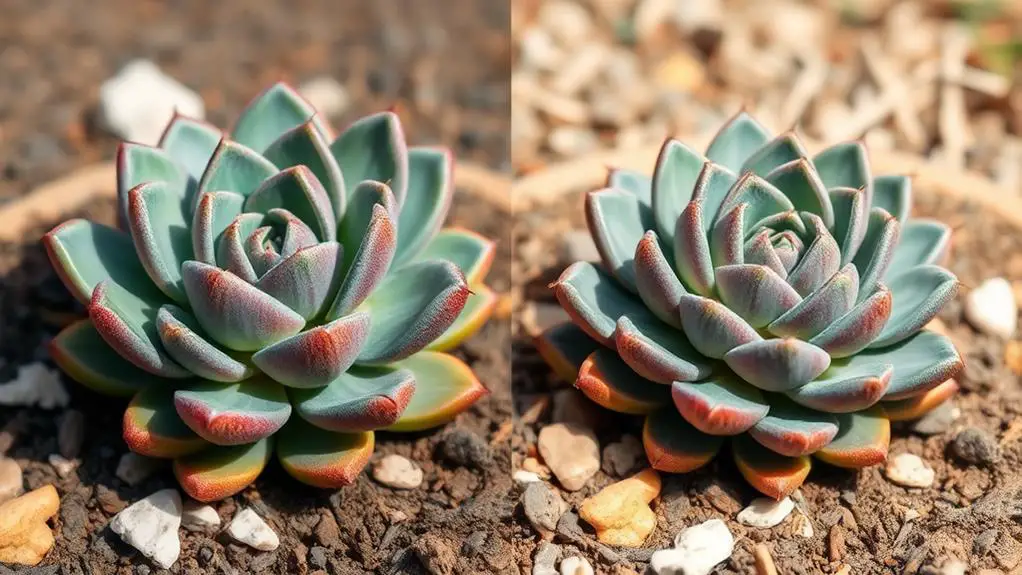
It's easy to mistake a dormant succulent for a dead one because both can show signs like leaf drop or discoloration.
However, a dormant succulent will have healthy roots, even if there's no new growth.
To tell if your plant is just resting or if it's in real trouble, check the roots; healthy roots mean dormancy, while rotted roots and a foul odor suggest the plant might be dead.
Recognizing Dormant Signs
Understanding the difference between dormancy and plant death in succulents can be tricky but essential for proper care. Recognizing signs of dormancy in succulents is important. You might notice a lack of new growth, which is one of the first signs. This can sometimes lead to confusion between dormancy and actual plant death.
Here are some key signs to look out for:
- Leaves: Dormant succulents may have leaves that turn yellow or brown, drop off, or hang limply. This indicates a shift in the plant's metabolic activity.
- Roots: Inspect the roots carefully. Healthy roots mean the plant is likely dormant. Rotted or shriveled roots, however, suggest the plant might be dead.
- Activity: Using the Snap-Scratch test can help you determine the plant's health. Healthy succulents snap without bending, while those that bend could be stressed or dying.
- Odor: A foul smell from the soil signals severe decay. This needs immediate attention to prevent further damage.
Recognizing these signs will help you understand whether your succulent is simply resting or if it requires immediate intervention. This knowledge is essential for ensuring your plant's long-term health.
Differentiating Dormant and Dead
Determining whether a succulent is dormant or dead can be challenging, but it's crucial for proper plant care. Dormant succulents might look lifeless with yellowing leaves, shriveling, or halted growth. However, their roots remain alive and capable of recovery. Healthy roots indicate dormancy, while rotten or shriveled roots suggest the plant is dead.
The Snap-Scratch test can also help you assess plant health. A healthy plant will snap cleanly without bending, while a dead or dying one won't. Understanding dormancy signs, like leaf shedding or rosette contraction, helps prevent misdiagnosis.
Here's a table to guide you:
| Signs | Dormant | Dead |
|---|---|---|
| Leaf Color | Yellowing | Brown or Black |
| Root Condition | Healthy roots | Rotten or Shriveled |
| Growth | Halted | No growth, decay |
| Odor | Neutral | Foul odor |
| Snap-Scratch Test | Snaps cleanly | Doesn't snap |
If your succulent shows signs of dormancy, keep it in a well-lit area and water sparingly. If it's dead, it's best to remove it to prevent the spread of decay. By recognizing these signs, you can better care for your succulents and ascertain their health.
Inspecting Root Health
Checking the roots is essential to discern whether your succulent is dormant or dead. When inspecting the roots, you'll want to look for signs of health or decay. Healthy roots are firm and white, while roots that are shriveled or rotted could mean the plant is dead.
Here's what to keep an eye on:
- Odor: A foul smell usually indicates severe decay and needs immediate action.
- Appearance: Healthy roots are firm and white, not brown or mushy.
- Snap-Scratch Test: Gently scratch or snap a root. A clean snap means it's healthy, while bending without breaking suggests death.
- Foliage: Dormant succulents may have minimal leaves, but their roots can still be alive.
Regular inspection during dormancy periods helps catch early signs of trouble.
If you notice any decay, you might be able to save the plant by removing the affected roots and repotting it in fresh soil.
Remember, a dormant succulent isn't dead; it's just resting. With proper care, those healthy roots will guarantee your plant bounces back when it's ready.
Don't worry, you've got this! Your succulent can thrive with a little attention and understanding.
Frequently Asked Questions
Why Do Succulents Go Dormant?
Succulents go dormant to survive extreme conditions. When it's too hot or too cold, they slow down their metabolism to conserve energy. You'll notice fewer leaves and color changes. During this time, they need minimal watering to avoid root rot.
What Season Do Succulents Go Dormant?
Succulents go dormant in different seasons based on their type. Winter dormant succulents like Echeveria slow down in winter, while summer dormant ones like Aloe Vera do so in summer. It helps them conserve energy during extreme temperatures.
What Temperature Do Succulents Go Dormant At?
Succulents go dormant when temperatures fall below 40°F or rise above 100°F, depending on the species. For winter-growers, dormancy starts below 60°F at night. For summer-growers, dormancy can begin above 50°F during dry conditions.
What Is Dormancy and Why Does It Happen?
Dormancy is when your succulent slows down growth to conserve energy during harsh conditions like extreme temperatures or drought. It helps your plant survive by reducing metabolic activity until favorable conditions return. Recognize dormancy to adjust your care routine.
Conclusion
Understanding succulent dormancy helps you care for your plants better. It's normal for succulents to slow down during tough seasons, so don't worry if they look less lively. Just adjust your watering and light accordingly, and be patient. Dormancy isn't a sign of poor health; it's a smart survival tactic. With the right care, your succulents will thrive again. Keep learning, stay observant, and trust that you're doing great as a gardener!

